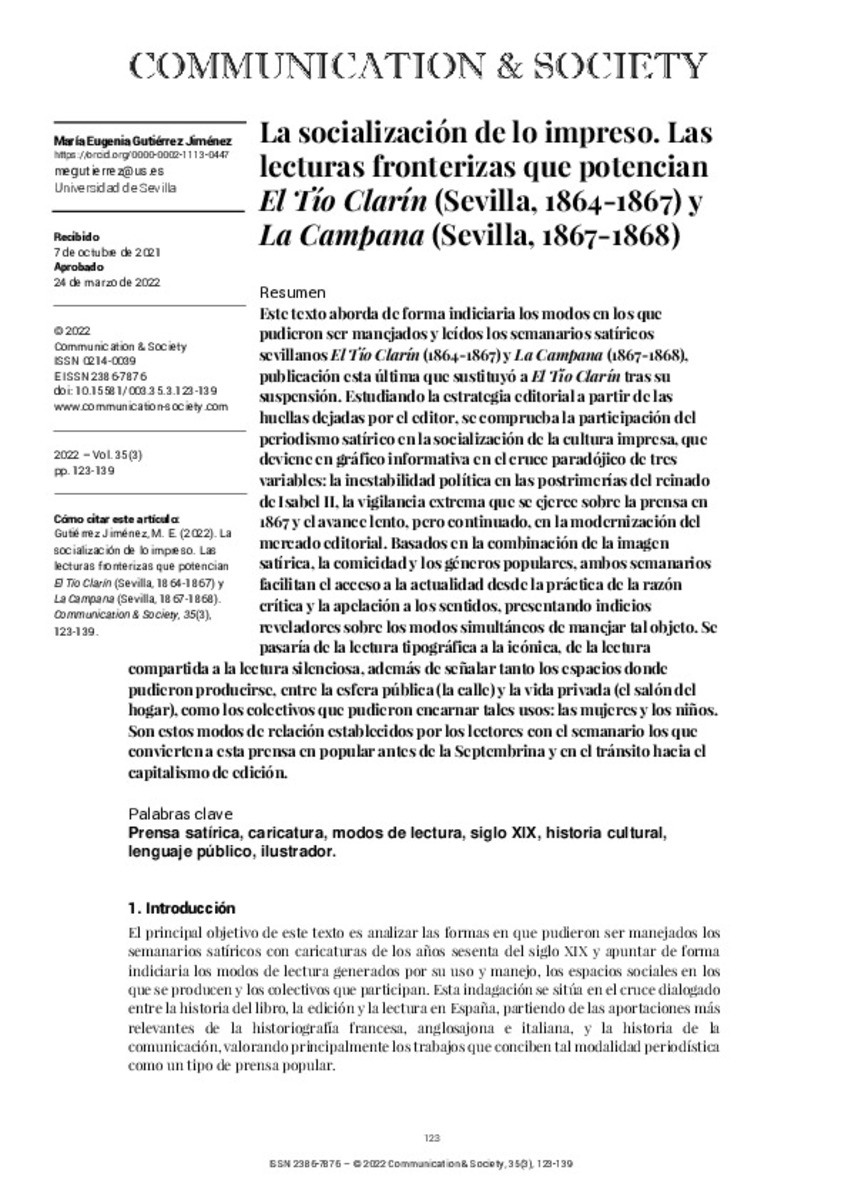Full metadata record
| DC Field | Value | Language |
|---|---|---|
| dc.creator | Gutiérrez-Jiménez, M.E. (María Eugenia) | - |
| dc.date.accessioned | 2022-06-07 | - |
| dc.date.accessioned | 2022-08-16T08:58:58Z | - |
| dc.date.available | 2022-08-16T08:58:58Z | - |
| dc.date.issued | 2022 | - |
| dc.identifier.citation | Gutiérrez-Jiménez, M.E. (María Eugenia). "The socialisation of print culture. Frontier ways of reading that promoted «El Tío Clarín» (Seville, 1864-1867) and «La Campana» (Seville, 1867-1868)". Communication & Society. 35 (3), 2022, 123 - 139 | es |
| dc.identifier.issn | 2386-7876 | - |
| dc.identifier.uri | https://hdl.handle.net/10171/63933 | - |
| dc.description.abstract | This paper addresses circumstantially the different ways in which the Seville satirical weeklies <em>El Tío Clarín</em> (1864-1867) and <em>La Campana</em> (1867-1868) –the latter replacing the former after its suspension– might have been read. By studying their editorial strategies on the basis of the footprints left by their editors, it is possible to determine how satirical journalism participated in the socialisation of print culture, which developed into informational graphics, despite the paradoxical confluence of three factors: the political instability in the final years of the reign of Isabella II, the tight censorship to which the press was subjected in 1867 and the slow but continuous progress in modernising the publishing market. Based on the combination of satirical cartoons, humour and popular genres, both weeklies made current affairs more accessible through critical reasoning and by appealing to the senses, with revealing indications of the simultaneous ways of addressing such a subject. Textual reading gave way to the graphic kind, reading aloud to doing so in silence, while the spaces in which this occurred, between the public (the street) and the private sphere (the parlour at home), and the collectives involved, namely, women and children, were determined. It was these ways of relating to the two weeklies, established by their readerships, that were behind the popularity of the satirical press before the Glorious Revolution of 1868 and the transition to publication capitalism. | en_US |
| dc.description.abstract | Este texto aborda de forma indiciaria los modos en los que pudieron ser manejados y leídos los semanarios satíricos sevillanos <em>El Tío Clarín</em> (1864-1867) y <em>La Campana</em> (1867-1868), publicación esta última que sustituyó a <em>El Tío Clarín</em> tras su suspensión. Estudiando la estrategia editorial a partir de las huellas dejadas por el editor, se comprueba la participación del periodismo satírico en la socialización de la cultura impresa, que deviene en gráfico informativa en el cruce paradójico de tres variables: la inestabilidad política en las postrimerías del reinado de Isabel II, la vigilancia extrema que se ejerce sobre la prensa en 1867 y el avance lento, pero continuado, en la modernización del mercado editorial. Basados en la combinación de la imagen satírica, la comicidad y los géneros populares, ambos semanarios facilitan el acceso a la actualidad desde la práctica de la razón crítica y la apelación a los sentidos, presentando indicios reveladores sobre los modos simultáneos de manejar tal objeto. Se pasaría de la lectura tipográfica a la icónica, de la lectura compartida a la lectura silenciosa, además de señalar tanto los espacios donde pudieron producirse, entre la esfera pública (la calle) y la vida privada (el salón del hogar), como los colectivos que pudieron encarnar tales usos: las mujeres y los niños. Son estos modos de relación establecidos por los lectores con el semanario los que convierten a esta prensa en popular antes de la Septembrina y en el tránsito hacia el capitalismo de edición. | es_ES |
| dc.language.iso | eng | - |
| dc.publisher | Servicio de Publicaciones de la Universidad de Navarra | es_ES |
| dc.rights | info:eu-repo/semantics/openAccess | es_ES |
| dc.subject | Prensa satírica | - |
| dc.subject | caricatura | - |
| dc.subject | modos de lectural | - |
| dc.subject | siglo XIX | - |
| dc.subject | historia cultural | - |
| dc.subject | lenguaje público | - |
| dc.subject | ilustrador | - |
| dc.title | The socialisation of print culture. Frontier ways of reading that promoted «El Tío Clarín» (Seville, 1864-1867) and «La Campana» (Seville, 1867-1868) | en_US |
| dc.type | info:eu-repo/semantics/article | es_ES |
| dc.identifier.doi | 10.15581/003.35.3.123-139 | - |
| dadun.citation.endingPage | 139 | - |
| dadun.citation.number | 3 | - |
| dadun.citation.publicationName | Communication & Society | - |
| dadun.citation.startingPage | 123 | - |
| dadun.citation.volume | 35 | - |
Statistics and impact
Items in Dadun are protected by copyright, with all rights reserved, unless otherwise indicated.







